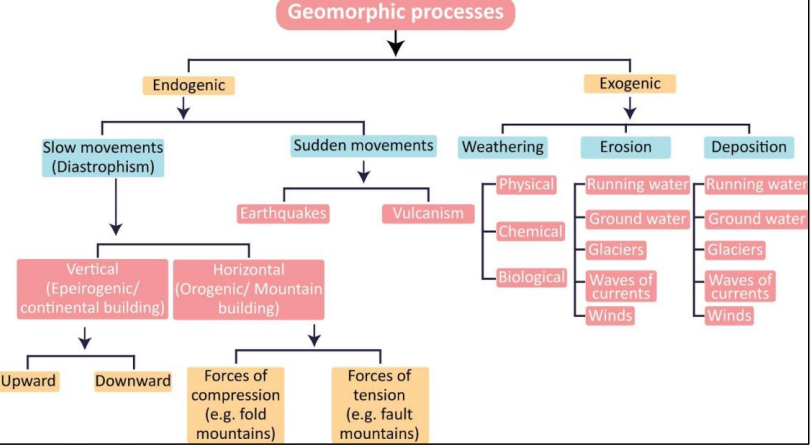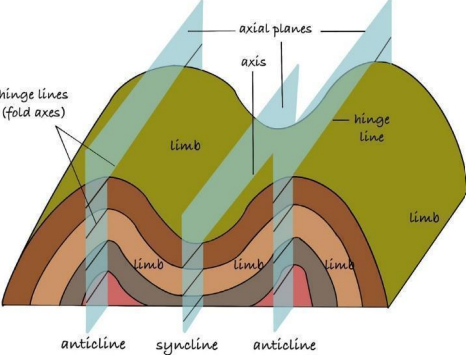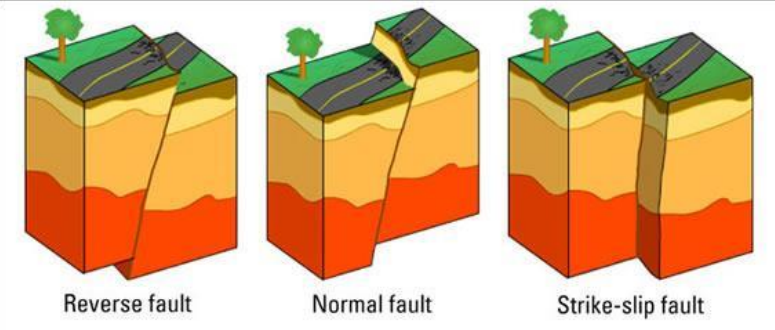Geography Playlist
19 chapters • 0 completed
The Universe and the Earth
18 topics
Atmosphere and its composition
6 topics
Atmospheric Temperature
11 topics
Atmospheric Moisture
9 topics
Air Mass, Fronts & Cyclones
15 topics
Evolution of Earths Crust, Earthquakes and Volcanoes
23 topics
Interior of The Earth
14 topics
Landforms
25 topics
Geomorphic Processes
10 topics
Movement of Ocean Water
16 topics
Oceans and its Properties
12 topics
Climate of a Region
14 topics
Indian Geography - introduction, Geology
5 topics
Physiography of India
27 topics
Indian Climate
20 topics
Indian Drainage
32 topics
Soil and Natural Vegetation
13 topics
Mineral and Energy Resources, Industries in India
28 topics
Indian Agriculture
22 topics
Chapter 9: Geomorphic Processes
Chapter TestGeomorphic Processes (Expanded)
Geomorphic processes are natural forces that shape Earth's landforms through the combined action of internal (endogenic) and external (exogenic) forces. Endogenic forces uplift, fold, fault, and create relief, while exogenic forces erode, transport, and deposit materials, constantly modifying the surface.
Geomorphic processes are natural forces that shape Earth's landforms through the combined action of internal (endogenic) and external (exogenic) forces. Endogenic forces uplift, fold, fault, and create relief, while exogenic forces erode, transport, and deposit materials, constantly modifying the surface.

Comparison of Endogenic and Exogenic Processes
| Aspect | Endogenic Processes | Exogenic Processes |
|---|---|---|
| Origin | Internal (within Earth) | External (climate, atmosphere) |
| Forces | Thermal, tectonic, radioactive | Solar energy, weather, gravity |
| Nature | Constructive (build landforms) | Destructive (erode/denude landforms) |
| Examples | Volcanoes, earthquakes, mountains, faults | Rivers, glaciers, wind, waves |
| Rate | Sudden (quakes) or long-term (folds) | Slow, continuous (weathering, erosion) |
Mains Key Points
Prelims Strategy Tips
Tectonic Landforms: Folds and Faults
Folds and faults are tectonic landforms created by endogenic forces due to plate movements. Folds result from compressional forces causing rocks to bend, while faults occur due to tension or compression leading to cracks and displacement of rock strata.
Folds and faults are tectonic landforms created by endogenic forces due to plate movements. Folds result from compressional forces causing rocks to bend, while faults occur due to tension or compression leading to cracks and displacement of rock strata.

Comparison of Folds and Faults
| Aspect | Folds | Faults |
|---|---|---|
| Definition | Bending of rock strata under compression | Fracture with displacement due to stress |
| Forces | Mainly compressional | Tensional, compressional, or shear forces |
| Resulting Landforms | Fold mountains, anticlines, synclines | Rift valleys, block mountains, fault scarps |
| Example | Himalayas (fold mountains) | San Andreas Fault (California), East African Rift Valley |
Mains Key Points
Prelims Strategy Tips
Types of Folds
Folds are bends in rock strata caused by compressional tectonic forces. Their type depends on rock nature, pressure intensity, and direction of stress. They are classified based on axial plane orientation, limb inclination, and degree of compressional force.
Folds are bends in rock strata caused by compressional tectonic forces. Their type depends on rock nature, pressure intensity, and direction of stress. They are classified based on axial plane orientation, limb inclination, and degree of compressional force.
Types of Folds – Summary
| Type | Characteristics | Formation |
|---|---|---|
| Symmetrical Fold | Vertical axial plane; equal limb dip | Moderate uniform compression |
| Asymmetrical Fold | Inclined axial plane; unequal limb dip | Unequal compressional force |
| Overturned Fold | Both limbs dip same direction at different angles | Strong inclined compression |
| Isoclinal Fold | Parallel limbs dip same direction | Very strong compression |
| Recumbent Fold | Horizontal axial plane; limbs parallel | Extreme compression (Alps) |
| Chevron | Sharp angular crests and troughs | Strong stress on resistant rocks |
| Fan Fold | Limbs overturned like fan | Excessive compression |
| Open Fold | Limb angle 90°–180° | Moderate compression |
| Closed Fold | Limb angle < 90°; thick crests | Intensive compression |
| Nappe | One limb overrides the other | Intense horizontal pressure |
| Anticlinorium | Series of small folds in a large anticline | Continued compression |
| Synclinorium | Series of small folds in a large syncline | Continued compression |
Mains Key Points
Prelims Strategy Tips
Faults
Faults are fractures in the Earth's crust where displacement of rock blocks has occurred due to tectonic forces. They can be vertical, horizontal, or inclined, and are classified into types such as normal, reverse, and strike-slip faults, each shaping major geomorphic landforms like rift valleys, horsts, and escarpments.
Faults are fractures in the Earth's crust where displacement of rock blocks has occurred due to tectonic forces. They can be vertical, horizontal, or inclined, and are classified into types such as normal, reverse, and strike-slip faults, each shaping major geomorphic landforms like rift valleys, horsts, and escarpments.

Comparison of Fault Types
| Type | Forces | Movement | Example |
|---|---|---|---|
| Normal Fault | Tension (pull-apart) | Hanging wall moves down | East African Rift Valley |
| Reverse Fault | Compression (push-together) | Hanging wall moves up | Himalayan thrust faults |
| Strike-Slip Fault | Shearing (horizontal sliding) | Blocks move sideways | San Andreas Fault, USA |
Mains Key Points
Prelims Strategy Tips
Exogenic Processes
Exogenic processes are destructive processes that wear down Earth's surface, collectively called denudation. Powered by solar energy, they include weathering, mass wasting, erosion, and transportation, driven by agents like rivers, wind, glaciers, and waves.
Exogenic processes are destructive processes that wear down Earth's surface, collectively called denudation. Powered by solar energy, they include weathering, mass wasting, erosion, and transportation, driven by agents like rivers, wind, glaciers, and waves.

Exogenic Processes and Their Characteristics
| Process | Description | Agent |
|---|---|---|
| Weathering | Breakdown of rocks in situ | Temperature, water, biological factors |
| Mass Movement | Downslope movement under gravity | Gravity, water saturation |
| Erosion | Wearing away of rock surface | Rivers, wind, glaciers, waves |
| Transportation | Movement of eroded material | Rivers, glaciers, wind, waves |
Mains Key Points
Prelims Strategy Tips
Weathering – Physical / Mechanical Weathering
Physical weathering is the breakdown of rocks into smaller fragments without any change in chemical composition. Dominant in arid, cold, and high-altitude regions due to temperature variation, frost action, and pressure release.
Physical weathering is the breakdown of rocks into smaller fragments without any change in chemical composition. Dominant in arid, cold, and high-altitude regions due to temperature variation, frost action, and pressure release.
Processes of Physical Weathering
| Process | Description | Examples |
|---|---|---|
| Frost Shattering | Water freezes in cracks, expands and breaks rock | Himalayas, Alps |
| Unloading / Exfoliation | Pressure release forms sheet joints and domes | Sierra Nevada, Mahabaleshwar |
| Insolation Weathering | Expansion & contraction due to temperature change | Sahara, Thar |
| Salt Weathering | Salt crystals grow in pores, exert pressure | Red Sea coast, Rann of Kutch |
Mains Key Points
Prelims Strategy Tips
Chemical and Biological Weathering
Chemical weathering alters the internal structure of minerals through reactions with water, oxygen, carbon dioxide, and acids. Biological weathering involves plants, animals, and human activities that physically or chemically break down rocks.
Chemical weathering alters the internal structure of minerals through reactions with water, oxygen, carbon dioxide, and acids. Biological weathering involves plants, animals, and human activities that physically or chemically break down rocks.
Processes of Chemical Weathering
| Process | Description | Example |
|---|---|---|
| Oxidation | Minerals react with oxygen → oxides & hydroxides | Rusting of iron-bearing rocks |
| Reduction | Occurs without oxygen, reverses oxidation | Swampy alluvial plains |
| Solution | Minerals dissolve in acids/water | Limestone caves |
| Carbonation | Carbonic acid reacts with carbonates | Karst topography |
| Hydration | Water added to minerals, expansion & cracking | Gypsum formation |
Mains Key Points
Prelims Strategy Tips
Mass Movements
Mass movements involve the downslope transfer of rock, soil, and debris solely under the influence of gravity. Unlike erosion, they are not driven by external geomorphic agents such as rivers, glaciers, or wind. They are common in unstable slopes with weak materials, heavy rainfall, or sparse vegetation.
Mass movements involve the downslope transfer of rock, soil, and debris solely under the influence of gravity. Unlike erosion, they are not driven by external geomorphic agents such as rivers, glaciers, or wind. They are common in unstable slopes with weak materials, heavy rainfall, or sparse vegetation.
Modes of Mass Movements
| Mode | Description | Examples |
|---|---|---|
| Slide | Movement along a shear plane with maximum motion at the base | Landslides in Himalayas |
| Flow | Material behaves like fluid; water saturation enhances flow | Debris flows in Western Ghats |
| Heave | Very slow movement caused by freeze-thaw or wetting-drying cycles | Soil creep in temperate regions |
Mains Key Points
Prelims Strategy Tips
Types of Mass Movements
Mass movements are downslope movements of soil, debris, or rock under gravity. They range from very slow (soil creep) to rapid and destructive events (landslides, avalanches).
Mass movements are downslope movements of soil, debris, or rock under gravity. They range from very slow (soil creep) to rapid and destructive events (landslides, avalanches).
Comparison of Major Mass Movements
| Type | Speed | Material Involved | Trigger |
|---|---|---|---|
| Solifluction | Very Slow | Water-saturated soil | Permafrost thawing |
| Soil Creep | Extremely Slow | Loose weathered soil | Gravity + freeze-thaw |
| Mudflow | Very Rapid | Mud, silt, water | Heavy rainfall, volcano |
| Earth Flow | Moderate | Soil and debris | Rainfall, localized saturation |
| Landslide | Sudden & Fast | Rock, soil, debris | Rainfall, earthquake, human activity |
| Liquefaction | Instantaneous | Saturated sediments | Earthquake shaking |
| Avalanche | Extremely Fast | Snow, ice, rock | Snowfall, slope instability, tremors |
Mains Key Points
Prelims Strategy Tips
Comparison – Weathering, Erosion and Mass Movement
Weathering is the breakdown of rocks in place, erosion is the wearing away and transportation of materials by agents, and mass movement is the downslope motion of debris solely under gravity.
Weathering is the breakdown of rocks in place, erosion is the wearing away and transportation of materials by agents, and mass movement is the downslope motion of debris solely under gravity.
Comparison of Weathering, Erosion and Mass Movement
| Aspect | Weathering | Erosion | Mass Movement |
|---|---|---|---|
| Definition | Breaking up or decomposing of rocks by water, air, chemicals, plants, or animals. | Earth materials worn away and transported by wind, water, ice, etc. | Transfer of rock and debris downslope solely under gravity. |
| Material Displacement | Rocks break but remain in place. | Broken materials are displaced by natural agents. | Rocks and debris move downslope without agents like wind/water. |
| Types | Physical, chemical, and biological weathering. | Soil erosion, coastal erosion, glacial erosion, etc. | Slow and rapid movements (soil creep, landslides, avalanches). |
| Causes | Atmospheric factors like rainfall, frost, air pressure, temperature changes. | Agents include water, wind, ice, human activities. | Caused entirely by gravity, though aided by rainfall or earthquakes. |
Mains Key Points
Prelims Strategy Tips
Chapter Complete!
Ready to move to the next chapter?
